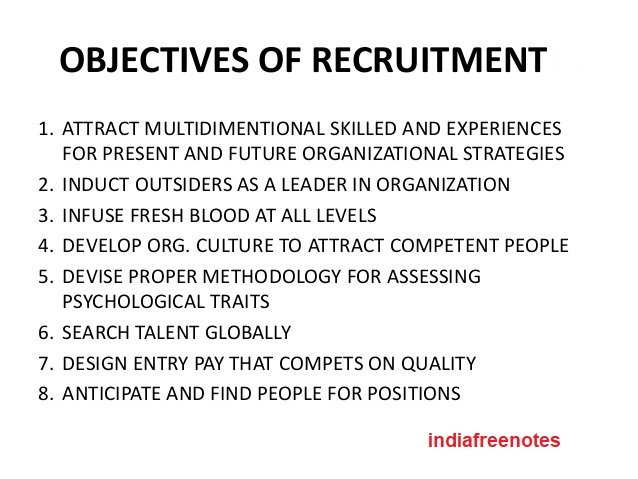Recruitment is a positive process of searching for prospective employees and stimulating them to apply for the jobs in the organization. When more persons apply for jobs then there will be a scope for recruiting better persons.
The job-seekers too, on the other hand, are in search of organizations offering them employment. Recruitment is a linkage activity bringing together those with jobs and those seeking jobs. In simple words, the term recruitment refers to discovering the source from where potential employees may be selected. The scientific recruitment process leads to higher productivity, better wages, high morale, reduction in labour turnover and enhanced reputation. It stimulates people to apply for jobs; hence it is a positive process.
Recruitment is concerned with reaching out, attracting, and ensuring a supply of qualified personnel and making out selection of requisite manpower both in their quantitative and qualitative aspect. It is the development and maintenance of adequate man- power resources. This is the first stage of the process of selection and is completed with placement.
Definition of Recruitment
According to Edwin B. Flippo, “It is a process of searching for prospective employees and stimulating and encouraging them to apply for jobs in an organization.” He further elaborates it, terming it both negative and positive.
He says, “It is often termed positive in that it stimulates people to apply for jobs, to increase the hiring ratio, i.e. the number of applicants for a job. Selection, on the other hand, tends to be negative because it rejects a good number of those who apply, leaving only the best to be hired. ”
In the words of Dale Yoder, Recruitment is the process to “Discover the sources of manpower to meet the requirements of the staffing schedule and to employ effective measures for attracting that manpower in adequate numbers to facilitate effective selection of an efficient working force.”
Kempner writes, “Recruitment forms the first stage in the process which continues with selection and ceases with the placement of the candidates.”
In personnel recruitment, management tries to do far more than merely fill job openings. As a routine the formula for personnel recruitment would be simple i.e., just fill the job with any applicant who comes along.
Joseph J. Famularo has said, “However, the act of hiring a man carries with it the presumption that he will stay with the company-that sooner or later his ability to perform his work, his capacity for job growth, and his ability to get along in the group in which he works will become matters of first importance.” Because of this, a critical examination of recruitment methods in use should be made.
Objectives of Recruitment Policy
Recruitment policy asserts the objectives of the recruitment and provides a framework of the implementation of the recruitment program.
It may involve the organization system to be developed for implementing recruitment programs and procedures to be employed.
According to Memoria, a good recruitment policy must contain elements such as
(i) Organization’s objective (short term and long term),
(ii) Identification of the recruitment needs,
(iii) The preferred source of recruitment,
(iv) Criteria of selection and preferences, and
(v) The cost of recruitment and its financial implications of the same. Objectives are targets and goals.
According to Yoder (1996), the following are the main objectives of recruitment policy:
- To find and employ the best-qualified person for each job.
- To minimize the cost of recruitment.
- To offer promising careers and security.
- To provide facilities for growth and development.
- To retain the best and most promising ones.
- To reduce the scope of favoritism and malpractice.

2 thoughts on “Recruitment: Meaning and Objectives”